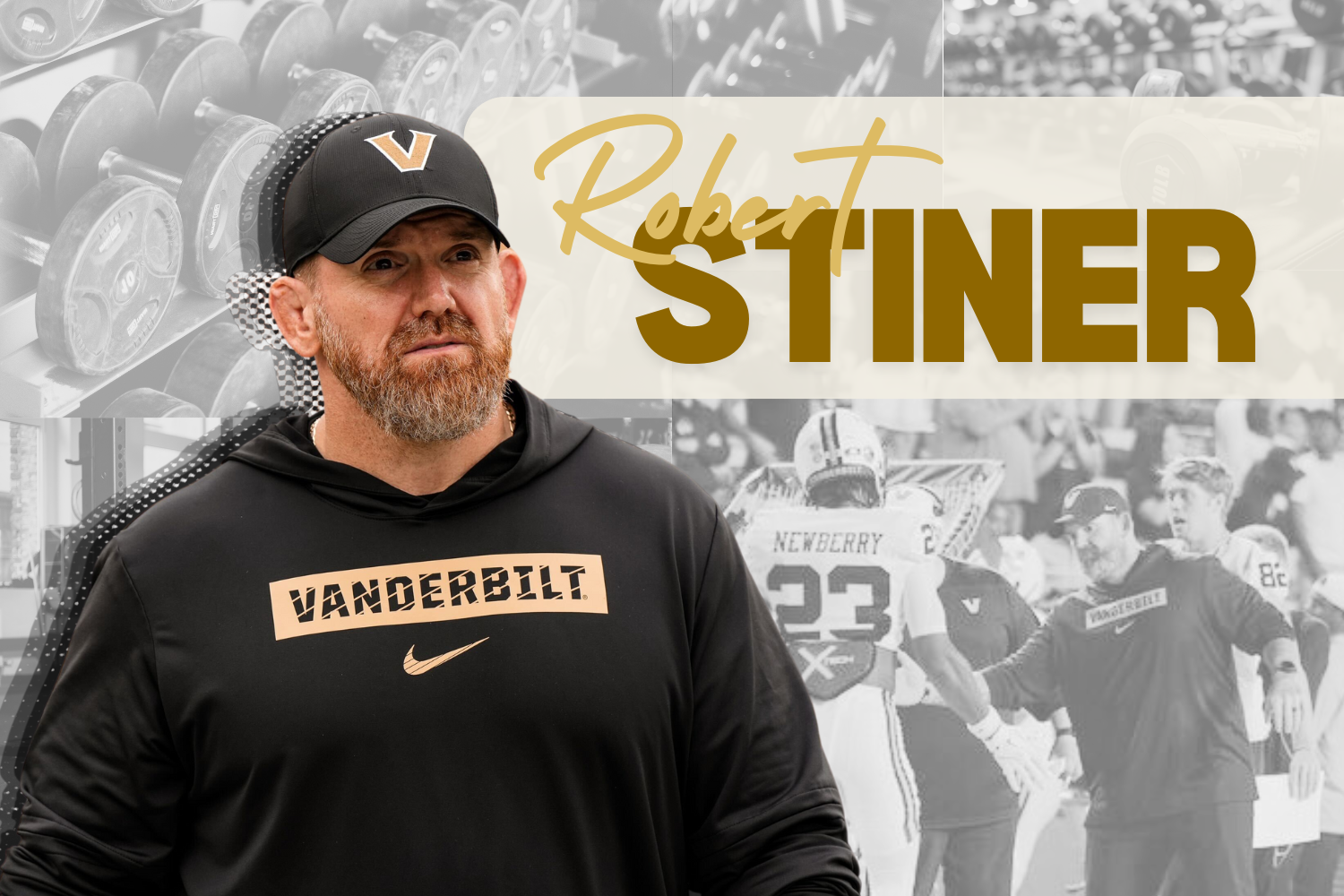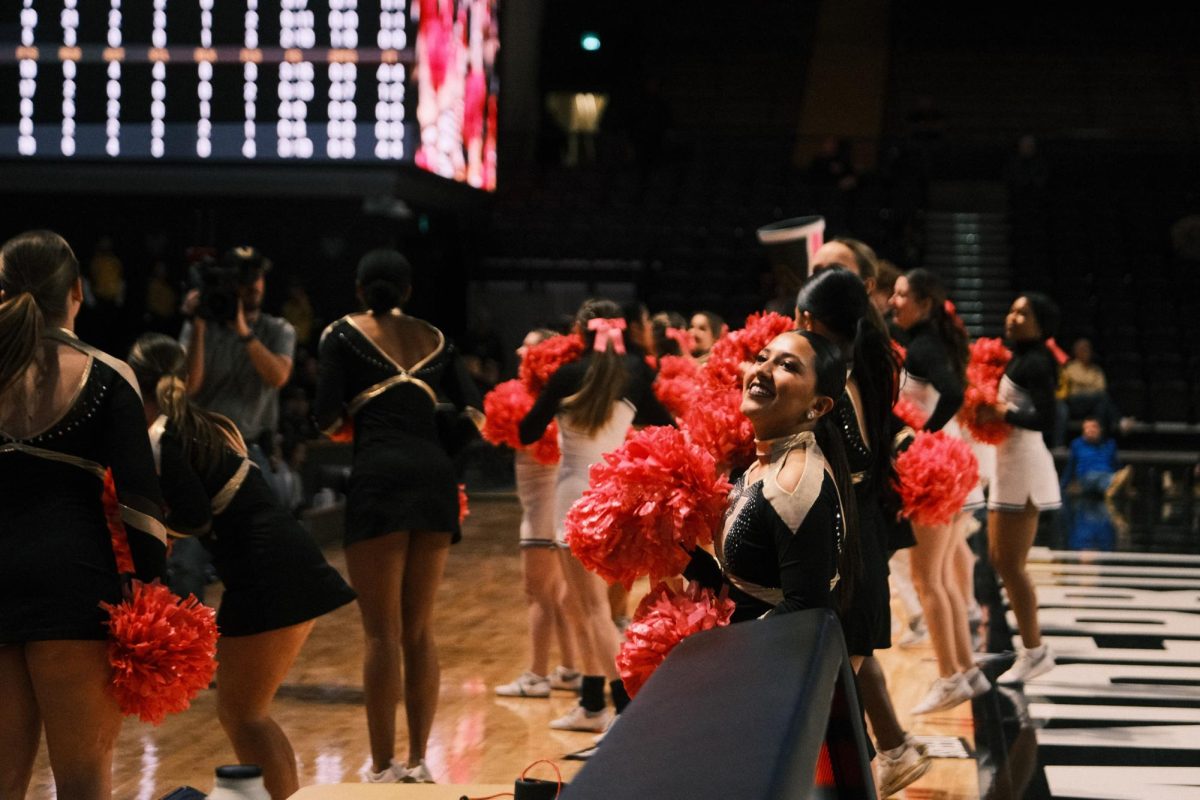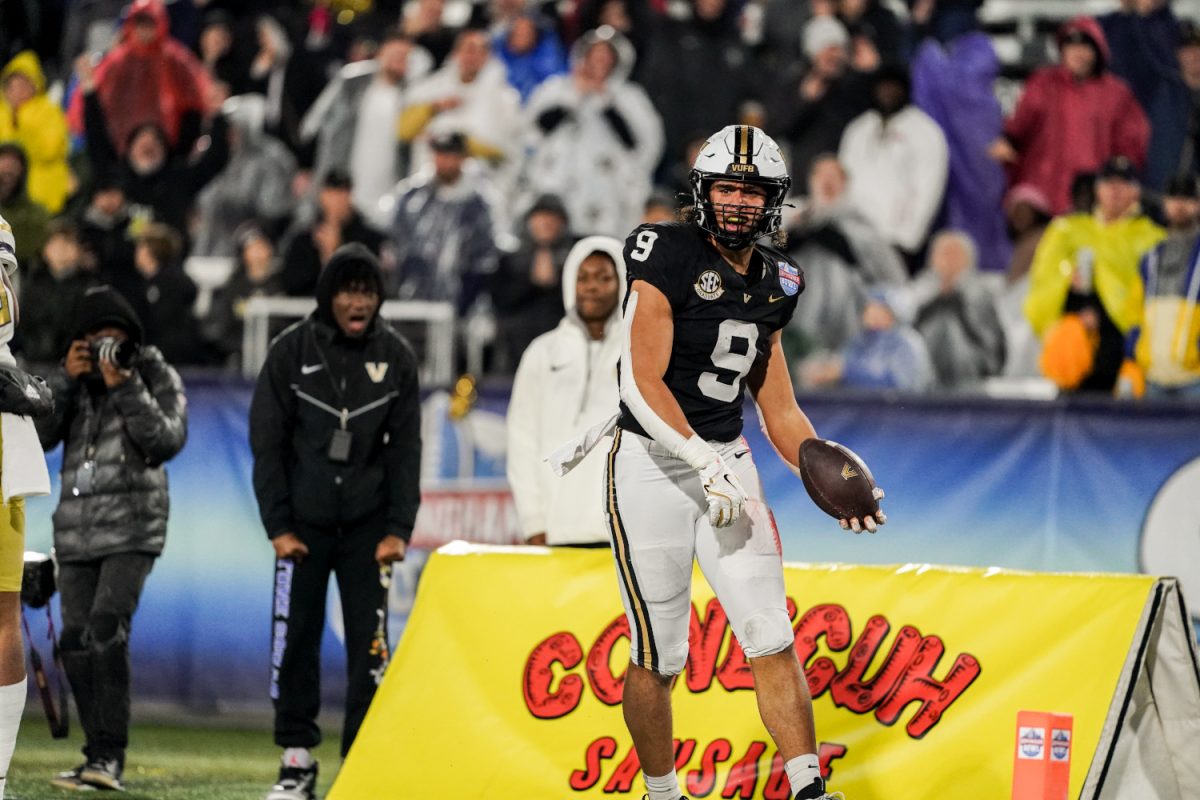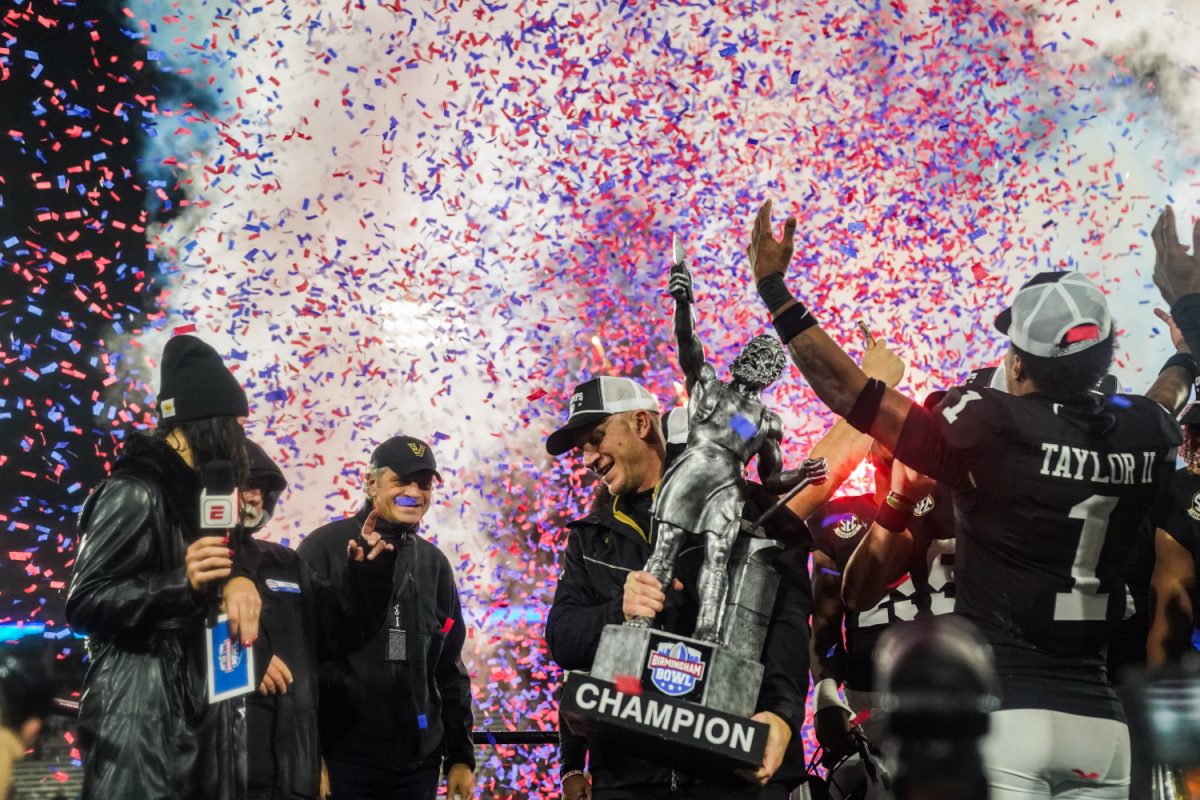The SEC is, without a doubt, the most physically imposing conference in college football. From freakishly tall defensive linemen to astonishingly fast pass catchers, the players in the conference are physically gifted. Vanderbilt Football has been characteristically undersized and overpowered since Clark Lea was hired as head coach, evidenced by a 2-22 record in SEC play from 2021-23. For Vanderbilt Football to truly compete with its peers, Lea knew he had to bring in a ringer.
Enter Robert Stiner, who joined Vanderbilt Football after the 2023 season, perhaps the lowest point of Lea’s tenure. The brand-new director of football sports performance — through an unmatched devotion to mentoring his players — has completely reinvigorated the Commodores’ locker room.
“[Stiner’s] a huge reason that almost the whole team is still healthy, still going each week, [getting] better and stronger,” linebacker Langston Patterson said. “A lot of times during the season, teams taper off and start getting weaker. For us, we just keep getting better as the season goes.”
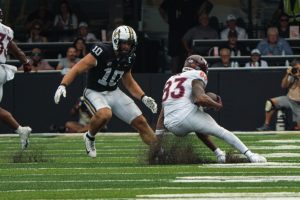
(Vince Lin)
After a disappointing 2-10 season in 2023, head coach Clark Lea made several changes to his coaching staff. The firing of offensive coordinator Joey Lynch and the demotion of defensive coordinator Nick Howell made headlines in national media, as did the subsequent hirings of Tim Beck (offensive coordinator) and Jerry Kill (chief consultant to the head coach). Stiner’s hiring, which occurred amid of all this revamping, flew largely under the radar.
Still, it didn’t take long for his presence to be felt. At the SEC Media Days in July, Lea noted the increased physicality across position groups, highlighted by the team’s edge rushers (up 16 pounds), tight ends (up 12 pounds) and safeties (up 10 pounds). He continued to rave about Stiner’s impact; not only were players stronger, but they were also more athletic.
“One of the things that I feel like is most impressive is that the speed has increased, but so has the weight. We’re becoming a faster team. We’re becoming a bigger team,” Lea said. “I credit Stiner with that. He’s been an absolute rockstar for us.”
Stiner began his foray into sports performance as an edge rusher at Belhaven University, a small school in Jackson, Mississippi, where he fell in love with the grind of hard work. He credits that grind, along with a great mentor in strength coach Bo Sandoval, for teaching him the craft.
“I’m very fortunate to have had a lot of really good mentors. It started in college, [where I] had a strength coach by the name of Bo Sandoval,” Stiner said. “[He’s] a guy that really opened the door for me. I was more of a work-hard guy [as opposed] to talent. I just started asking questions, and that grew my passion.”
Stiner graduated from Belhaven University in 2008 with a degree in sports administration, but he originally came in as an accounting major. While many might fail to see the connection between accounting and sports performance, the two shared a common theme in Stiner’s mind: math.
“I always joke with the guys that I started as an accounting major and I love math. Ultimately, dressing up in a suit and tie and sitting in a cubicle all day wasn’t for me,” Stiner said. “You get to see a lot of that in play with strength and conditioning: it’s a lot of math, physics and science.”
Stiner’s love of math and physical fitness carried him to Valdosta State, where he graduated with a master’s degree in health and physical education/fitness in 2011. He wasted little time getting back to the gridiron after that, getting his first SEC experience as a strength and conditioning intern at LSU. He then worked in Starkville with Mississippi State’s football program as an assistant coach before getting his first job leading strength and conditioning with the University of Central Arkansas.
Stiner bounced around for a few years, serving stints at FIU and Cincinnati before settling in at Notre Dame from 2018 to 2020. This is where Stiner met Lea — the two worked for the Fighting Irish for the same three seasons. Stiner was the assistant director of football strength and conditioning and Lea was the defensive coordinator.
“I was fortunate though to be at Notre Dame from 2018 through 2020,” Stiner said. “I was able to have a relationship with Coach Lea and see his process, to see what type of person he is and to develop that relationship.”
After Stiner left South Bend, he spent time at the University of Southern California and Georgia Southern University for the 2021, 2022 and 2023 football seasons. When Vanderbilt Football began the process of reshuffling its coaching staff and an opportunity to work with Lea again presented itself, he jumped on it.
Lea — who was already vocal about Stiner’s impact this summer — has sung his colleague’s praise early this season too.
“He’s helped build a culture of toughness where these guys mentally and physically feel equipped for the task,” Lea said. “He [did] a really nice job in the summer preparing the team for a tough fall camp, and [spent] fall camp sustaining that through. [During] the season, [he’s continued] to pay attention to elements of the training that are helping our guys.”
Lea always knew that Stiner was among the most knowledgeable members of the sports performance field, but it wasn’t until the duo started training together that Vanderbilt’s head coach picked up on Stiner’s depth of knowledge.
“A lot of times in our conversations, I just have to nod. I like to think that I know a little bit about training, but his understanding of what the muscles and tendons need [is unmatched],” Lea said. “I know this first-hand because I train with him three times a week. I can’t say enough about him, the attitude he’s brought [and] how aligned that [weight] room is with the program we’re building.”
Stiner’s rise through the ranks of strength and conditioning was a result of the relationships he cultivated and the mentors who guided him. He’s carried that relationship-oriented approach with him to Vanderbilt, from his early-morning lifts with Lea to being a resource for his team.
“The most important lesson that [I’ve been] taught was investment in the athlete. [Building] the relationship you have and being able to equip young men with [the tools] to succeed,” Stiner said. “We’re support staff for a reason. For us, the primary goal is for us to be available and give our guys what they need to be successful.”
For Stiner, preparing his athletes for success on the field starts in the weight room.
“My favorite part of this whole thing is the performance piece. How does what we do in the weight room apply to the field?” Stiner said. “We’re making sure that we’re putting things in place and [our players] are at optimal body weights so that guys can function proficiently and effectively.”
That success comes in all sorts of forms, and while it might begin at the squat racks and bench presses, Stiner’s holistic approach goes much further than that.
“It’s a collaborative effort. Some of the speed and weight gain, none of this takes place without [our] phenomenal nutrition program. You want to make sure that the lean body mass side is being driven, not just body fat percentage,” Stiner said. “The byproduct of that [balance] is speed development, and that’s one of the metrics that we can use to check [ourselves].
While his approach has followed a similar blueprint thanks to the number of programs he’s worked with, Stiner knows that there’s no room for complacency. He’s obsessed with the process and determined to perfect his craft.
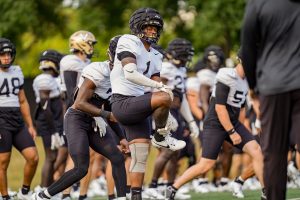
“In any profession, you have a mission. You have a blueprint of what it should look like and things that you believe in,” Stiner said. “But you can’t just carry the same things into each season. You can’t just have a cookie cutter program, you have to introduce new stimuli and tweak your programming.”
The introduction of artificial intelligence has been a major development in the sports performance sphere. Stiner and the rest of the Commodores’ strength and conditioning team can create personalized plans to ensure athletes’ health thanks to devices like Catapults and Nordbords.
“Utilizing the technology component [of training] is huge. It’s going to give us the feedback we need,” Stiner said. “The Catapult looks at speed [and] player load, [which tracks] the output of our guys. We also utilize a velocity-based training system, [which] helps us to pinpoint different training stimuli that we need. The Nordbord [helps us evaluate things] from an injury standpoint, and that allows us to create checks and balances.”
With all of these technological advancements comes progress in the field of injury prevention, but not a solution. When it comes to football, the most extreme contact sport out there, injuries pop up all the time. Being at a top-tier academic institution like Vanderbilt, in conjunction with competing in the most imposing conference in football, only enhances the probability of injury.
Stiner’s philosophy is one of checks and balances — balancing the need for injury awareness with building muscle isn’t easy, but Vanderbilt’s done a good job staying healthy through the early parts of the season.
“I wish there was a solid answer [to injury prevention] and whoever has that answer is going to make a lot of money,” Stiner said. “There are a million factors that come into play, especially at an academic institution, when we know that academic stress increases the likelihood of injury by 30%. Adding muscle mass is like adding armor to the body, and the other component is flexibility and mobility.”
Stiner has ensured that his players have a proper distribution of strength and mobility. The combination of the two is essential for all football players but the focus will vary based on players’ body types and positions. Specialists like quarterbacks and kickers are always going to be more focused on rotational force and spinal mobility than some of their peers.
He also knows that nothing is more important for football players than preventing brain injuries. As the number of concussions football players suffer rises every year, the need to protect player’s heads is higher than ever. Stricter officiating — though important — won’t cut it, and Stiner knows that.
“One of the things that we always hang our hat on is protecting the brain — your most vital resource,” Stiner said. “The stronger the traps, the thicker the neck and the less likely [you are to get] a concussion. We track that constantly with our guys.”
Beyond all of this, though, Stiner emphasized what many of the black and gold faithful have already perceived: this team is different. A 2-2 record might not be what Vanderbilt wanted at this juncture of the season, but Lea and the rest of the staff possess an overwhelming belief that the Commodores are better than their record indicates. They’re resilient.
Riding high after wins over Virginia Tech and Alcorn State, Vanderbilt suffered a crushing defeat at the hands of Georgia State and fell just short of a program-defining upset over Missouri. However, the confidence in the McGugin Center, from walk-ons to Lea, hasn’t faltered.
“The level of care and brotherhood that they have [is different]. You see them competing for one another and with one another, and that’s huge,” Stiner said. “They’re resilient, they’ll fight for four quarters. They’re never to be taken lightly.”

He and the rest of Vanderbilt Football will face a massive challenge — both in physical stature and quality of team — when No. 1 Alabama comes to town for a 3:15 p.m. CDT clash on Oct 5. The Crimson Tide is known for its bruising, brown-nosed style of play, and the Commodores will certainly have their work cut out for them. If there’s anything to take away from Stiner’s first nine months on West End, it’s that the black and gold won’t shine away from a challenge.


